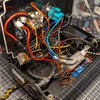- Joined
- Mar 12, 2025
- Messages
- 12
Now that summer's upon many of us, I thought I'd share my solution for keeping critters cool.
I use an aquarium chiller to cool water that's then pumped through a therapy mat beneath the enclosure. It's a bit of a DIY project, but it's worked very well for me. This is my Google Doc breaking down the parts and performance.
With this I keep my Banana Slug's substrate at 55F (13C) year-round, despite the ambient ranging from 70-80F (21-27C).



I use an aquarium chiller to cool water that's then pumped through a therapy mat beneath the enclosure. It's a bit of a DIY project, but it's worked very well for me. This is my Google Doc breaking down the parts and performance.
With this I keep my Banana Slug's substrate at 55F (13C) year-round, despite the ambient ranging from 70-80F (21-27C).



Last edited:


